airbag MINI COOPER 2004 Owners Manual
[x] Cancel search | Manufacturer: MINI, Model Year: 2004, Model line: COOPER, Model: MINI COOPER 2004Pages: 152, PDF Size: 1.53 MB
Page 5 of 152
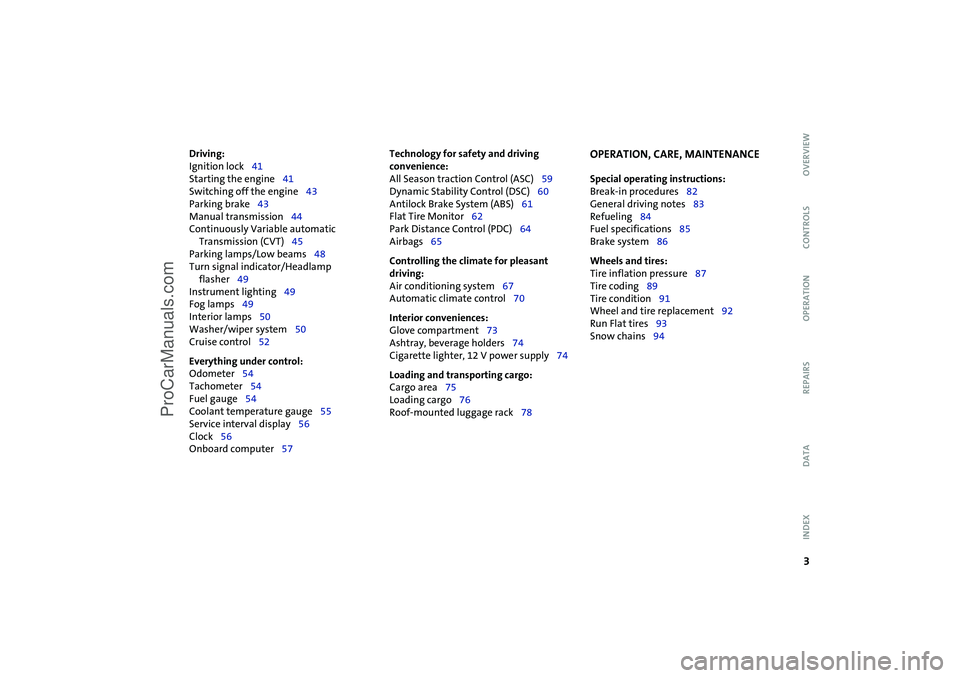
3
OVERVIEW REPAIRS OPERATION CONTROLS DATA INDEX
Driving:
Ignition lock41
Starting the engine41
Switching off the engine43
Parking brake43
Manual transmission44
Continuously Variable automatic
Transmission (CVT)45
Parking lamps/Low beams48
Turn signal indicator/Headlamp
flasher49
Instrument lighting49
Fog lamps49
Interior lamps50
Washer/wiper system50
Cruise control52
Everything under control:
Odometer54
Tachometer54
Fuel gauge54
Coolant temperature gauge55
Service interval display56
Clock56
Onboard computer57
Technology for safety and driving
convenience:
All Season traction Control (ASC)59
Dynamic Stability Control (DSC)60
Antilock Brake System (ABS)61
Flat Tire Monitor62
Park Distance Control (PDC)64
Airbags65
Controlling the climate for pleasant
driving:
Air conditioning system67
Automatic climate control70
Interior conveniences:
Glove compartment73
Ashtray, beverage holders74
Cigarette lighter, 12 V power supply74
Loading and transporting cargo:
Cargo area75
Loading cargo76
Roof-mounted luggage rack78
OPERATION, CARE, MAINTENANCE
Special operating instructions:
Break-in procedures82
General driving notes83
Refueling84
Fuel specifications85
Brake system86
Wheels and tires:
Tire inflation pressure87
Tire coding89
Tire condition91
Wheel and tire replacement92
Run Flat tires93
Snow chains94
ProCarManuals.com
Page 18 of 152
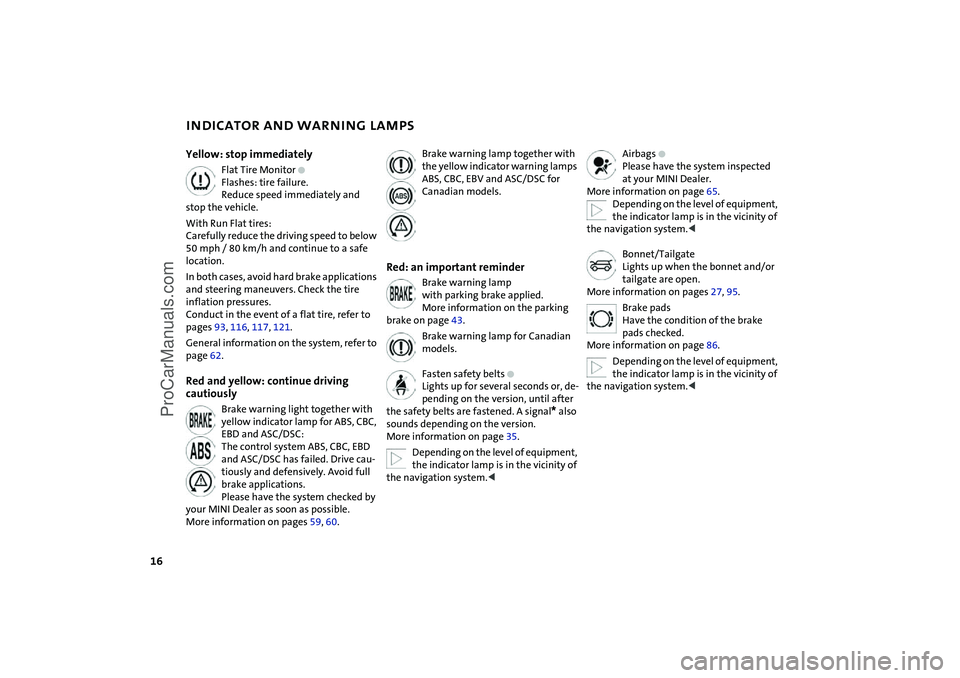
16
INDICATOR AND WARNING LAMPS
Yellow: stop immediately
Flat Tire Monitor
+
Flashes: tire failure.
Reduce speed immediately and
stop the vehicle.
With Run Flat tires:
Carefully reduce the driving speed to below
50 mph / 80 km/h and continue to a safe
location.
In both cases, avoid hard brake applications
and steering maneuvers. Check the tire
inflation pressures.
Conduct in the event of a flat tire, refer to
pages 93, 116, 117, 121.
General information on the system, refer to
page 62.
Red and yellow: continue driving
cautiously
Brake warning light together with
yellow indicator lamp for ABS, CBC,
EBD and ASC/DSC:
The control system ABS, CBC, EBD
and ASC/DSC has failed. Drive cau-
tiously and defensively. Avoid full
brake applications.
Please have the system checked by
your MINI Dealer as soon as possible.
More information on pages 59, 60.
Brake warning lamp together with
the yellow indicator warning lamps
ABS, CBC, EBV and ASC/DSC for
Canadian models.
Red: an important reminder
Brake warning lamp
with parking brake applied.
More information on the parking
brake on page 43.
Brake warning lamp for Canadian
models.
Fasten safety belts
+
Lights up for several seconds or, de-
pending on the version, until after
the safety belts are fastened. A signal
*
also
sounds depending on the version.
More information on page 35.
Depending on the level of equipment,
the indicator lamp is in the vicinity of
the navigation system.
<
Airbags
+
Please have the system inspected
at your MINI Dealer.
More information on page 65.
Depending on the level of equipment,
the indicator lamp is in the vicinity of
the navigation system.
<
Bonnet/Tailgate
Lights up when the bonnet and/or
tailgate are open.
More information on pages 27, 95.
Brake pads
Have the condition of the brake
pads checked.
More information on page 86.
Depending on the level of equipment,
the indicator lamp is in the vicinity of
the navigation system.
<
ProCarManuals.com
Page 33 of 152

31
OVERVIEW REPAIRS OPERATIONCONTROLS DATA INDEX
SAFE SEATING POSITIONThe ideal seating position can make a vital
contribution to relaxed, relatively fatigue-
free driving. Together with the safety belts
and airbags, the seating position also plays
an important role in providing occupants
with maximum levels of passive safety in
an accident. To ensure that the safety sys-
tems operate with optimal efficiency, we
strongly urge you to observe the instruc-
tions contained in the following section.
For additional information about trans-
porting children safely, refer to page 38.Sitting safely with airbags
Always maintain an adequate dis-
tance between yourself and all of the
airbags. Always hold the steering wheel by
the rim with the hands at the 9 and
3 o'clock positions to keep any chance of
injury to hands or arms to an absolute min-
imum, should the airbag be deployed.
No one and nothing is to come between
the airbags and the seat occupant. Do not
use the front passenger airbag cover as a
storage surface for objects of any kind.
Ensure that the front passenger is correctly
seated, i.e. that no feet or legs are propped
against the dashboad. Otherwise, leg injury
could result if the front passenger airbag
suddenly deployed. Never let an occupant's
head rest near or on a side airbag because
the inflating airbag could cause a serious or
fatal injury.<
Even if all these instructions are followed, it
cannot entirely be ruled out that in some
circumstances injury may result from con-
tact with the airbags. In sensitive individu-
als, the ignition and inflation noise may
induce a mild hearing loss that is usually
temporary.
For airbag locations and additional infor-
mation on airbags, refer to page 65.Safe seating position with safety belt Fasten your safety belt before each drive.
Airbags are an additional safety device and
work in conjunction with the safety belts,
but do not replace them.
Your vehicle is equipped with four seats,
each of which is provided with a safety belt.
At all times, occupants should sit
upright and be properly restrained –
infants and small children in appropriate
child-restraint systems; larger children and
adults using the safety belts.
Expectant mothers should always wear
their safety belts, taking care to position
the lap belt against the lower hips, where it
will not exert pressure against the abdomi-
nal area.
Never allow more than one person to wear
a single safety belt. Never allow infants or
small children to ride in a passenger's lap.
Do not route the belt across your neck, or
run it across sharp edges. Be sure that the
belt does not become caught or jammed.
Avoid twisting the belt while routing it
firmly across the hips and shoulder; wear it
as snugly against your body as possible and
do not allow it to rest against sharp or frag-
ile objects. Otherwise, the belt could slide
over your hips in the event of a frontal
impact and cause abdominal injury. Avoid
wearing bulky clothing and pull on the lap
belt periodically to retension it over your
shoulder. Otherwise, the safety belt's
restraint effectiveness could be reduced.<
For information on using the safety belts,
refer to page 35.
ProCarManuals.com
Page 40 of 152

38
TRANSPORTING CHILDREN SAFELY The proper place for childrenChildren should always sit in the rear:
Accident research shows that the safest
place for children in a vehicle is in the rear
seat.
Older children should be tightly secured
with a safety belt, after they have out-
grown a booster seat that is appropriate for
their age, height and weight.
A child sitting in the rear seat and not
properly restrained may place his or
her head on or near the airbag, if so
equipped. For example, a child – even
though belted – may fall asleep with his or
her head against the side airbag. It may be
difficult for a driver to ensure that children
in the rear seat will remain properly posi-
tioned at all times and do not place their
heads on or near the side airbag. Therefore,
we recommend that the rear side airbags, if
provided, be deactivated if you plan to
transport children in the rear seat.<
Child-restraint system in the rear
Children under 13 years of age and
children less than 5 ft / 150 cm tall
should always ride in the rear and the
restraint systems should be secured with
the vehicle's safety belts.<
Younger children should be secured in an
appropriate forward-facing child-restraint
system that has first been properly
restrained. We strongly urge you to care-
fully read and comply with the instructions
for installation and use provided by the
child-restraint's manufacturer whenever
you use such a device.
All rear seating positions in your vehicle
meet the recommendations of SAE J1819,
an industry-recommended practice for
securing child-restraint systems in motor
vehicles.
Exception for the front passenger seat
Never install a rearward-facing child-
restraint system in the front passen-
ger seat of this vehicle if the passenger's
airbag is not deactivated. If you do so, the
child could be severely injured or killed
when the airbag is triggered. Your vehicle is
equipped with an airbag supplemental
restraint system for the front passenger.
Because the backrest on any rearward-fac-
ing child-restraint system – of the kind
designed for infants under 1 year and
20 Ibs / 9 kg – would be within the airbag's
deployment range, you should never
mount such a system in the front passen-
ger seat, since the impact of the airbag
against the child restraint's backrest could
lead to serious or fatal injuries.<
ProCarManuals.com
Page 67 of 152

65
OVERVIEW REPAIRS OPERATIONCONTROLS DATA INDEX
AIRBAGS1Side airbags in seatback on the driver
and passenger side: front
2Head airbags on the driver and passenger
sides for both rows of seats: front/rear
3Front airbags on the driver and passen-
ger sidesProtective effectThe front airbags supplement the safety belts
by providing additional protection for the
driver and front passenger in the event of a
frontal collision in which the protection
afforded by the belts alone may no longer be
sufficient.
When needed, the head and side airbags help
to furnish protection in the event of side
impact.
Each of the side airbags is designed to help
support the seat occupant's upper body.
The airbags are designed to not be trig-
gered in certain types of collisions, e.g. in
minor accidents, certain kinds of vehicle
rollover and rear impact.
For information on the ideal seating position,
refer to page 31.
Do not apply adhesive materials to the
cover panels of the airbags, cover them
or modify them in any other way. Do not fit
covers, cushions or other items to the front
seats that have not been specially approved
for seats with side airbags. Do not hang cloth-
ing, e. g. jackets, over the backrests.
Do not attempt to remove the airbag
restraint system from the vehicle. Do not
make any changes yourself to the individual
components and wiring. This includes the
padded covers of the steering wheel, instru-
ment panel and roof supports, as well as the
sides of the roofliner and the original back-
rest covers on the front seats. Do not attempt
to remove or dismantle the steering wheel.
Do not touch the individual components
directly after the system has been triggered,
as otherwise there is a danger of burns. In the
event of malfunctions, immobilization or use,
i.e. triggering, of the airbag restraint system
in accordance with its intended function,
please commission a MINI Dealer with the
inspection, repair or disassembly. Unprofes-
sional attempts to service the system could
lead to failure in an emergency or undesired
airbag activation, either of which could result
in personal injury. In view of the applicable
safety regulations, please arrange for your
MINI Dealer to dispose of the airbag genera-
tors.<
Airbag warning information is also pro-
vided on the sun visors.Indicator lamp
The indicator lamp in the display
elements shows the status of the
entire airbag system and the seat
belt tensioners starting from ignition key
position 1.
System operational:
>The indicator lamp comes on briefly.
System malfunction:
>The indicator lamp does not come on
starting from ignition key position 1
>The indicator lamp stays lit
>The indicator lamp lights up while driving.
ProCarManuals.com
Page 68 of 152

66
AIRBAGS
A system malfunction could prevent
the airbags from deploying in
response to a severe impact occurring
within the system's normal triggering
range. Please have the airbag system
checked as soon as possible by your MINI
Dealer.
<
ProCarManuals.com
Page 140 of 152
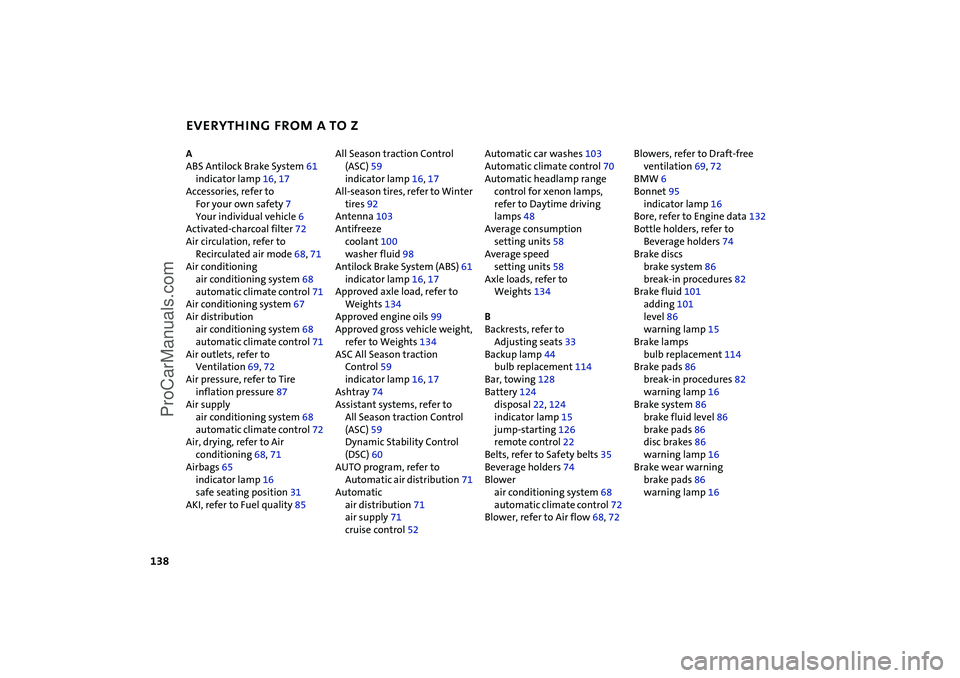
EVERYTHING FROM A TO Z
138
A
ABS Antilock Brake System 61
indicator lamp 16, 17
Accessories, refer to
For your own safety 7
Your individual vehicle 6
Activated-charcoal filter 72
Air circulation, refer to
Recirculated air mode 68, 71
Air conditioning
air conditioning system 68
automatic climate control 71
Air conditioning system 67
Air distribution
air conditioning system 68
automatic climate control 71
Air outlets, refer to
Ventilation 69, 72
Air pressure, refer to Tire
inflation pressure 87
Air supply
air conditioning system 68
automatic climate control 72
Air, drying, refer to Air
conditioning 68, 71
Airbags 65
indicator lamp 16
safe seating position 31
AKI, refer to Fuel quality 85 All Season traction Control
(ASC) 59
indicator lamp 16, 17
All-season tires, refer to Winter
tires 92
Antenna 103
Antifreeze
coolant 100
washer fluid 98
Antilock Brake System (ABS) 61
indicator lamp 16, 17
Approved axle load, refer to
Weights 134
Approved engine oils 99
Approved gross vehicle weight,
refer to Weights 134
ASC All Season traction
Control 59
indicator lamp 16, 17
Ashtray 74
Assistant systems, refer to
All Season traction Control
(ASC) 59
Dynamic Stability Control
(DSC) 60
AUTO program, refer to
Automatic air distribution 71
Automatic
air distribution 71
air supply 71
cruise control 52 Automatic car washes 103
Automatic climate control 70
Automatic headlamp range
control for xenon lamps,
refer to Daytime driving
lamps 48
Average consumption
setting units 58
Average speed
setting units 58
Axle loads, refer to
Weights 134
B
Backrests, refer to
Adjusting seats 33
Backup lamp 44
bulb replacement 114
Bar, towing 128
Battery 124
disposal 22, 124
indicator lamp 15
jump-starting 126
remote control 22
Belts, refer to Safety belts 35
Beverage holders 74
Blower
air conditioning system 68
automatic climate control 72
Blower, refer to Air flow 68, 72 Blowers, refer to Draft-free
ventilation 69, 72
BMW 6
Bonnet 95
indicator lamp 16
Bore, refer to Engine data 132
Bottle holders, refer to
Beverage holders 74
Brake discs
brake system 86
break-in procedures 82
Brake fluid 101
adding 101
level 86
warning lamp 15
Brake lamps
bulb replacement 114
Brake pads 86
break-in procedures 82
warning lamp 16
Brake system 86
brake fluid level 86
brake pads 86
disc brakes 86
warning lamp 16
Brake wear warning
brake pads 86
warning lamp 16
ProCarManuals.com
Page 143 of 152
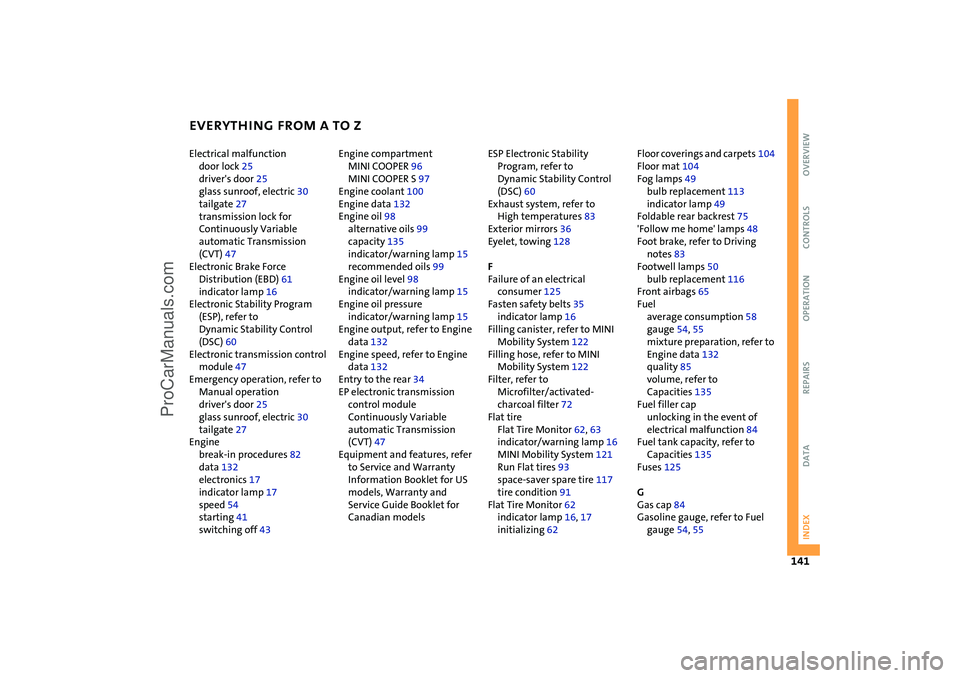
EVERYTHING FROM A TO Z
141
OVERVIEW REPAIRS OPERATION CONTROLS DATA INDEX
Electrical malfunction
door lock 25
driver's door 25
glass sunroof, electric 30
tailgate 27
transmission lock for
Continuously Variable
automatic Transmission
(CVT) 47
Electronic Brake Force
Distribution (EBD) 61
indicator lamp 16
Electronic Stability Program
(ESP), refer to
Dynamic Stability Control
(DSC) 60
Electronic transmission control
module 47
Emergency operation, refer to
Manual operation
driver's door 25
glass sunroof, electric 30
tailgate 27
Engine
break-in procedures 82
data 132
electronics 17
indicator lamp 17
speed 54
starting 41
switching off 43 Engine compartment
MINI COOPER 96
MINI COOPER S 97
Engine coolant 100
Engine data 132
Engine oil 98
alternative oils 99
capacity 135
indicator/warning lamp 15
recommended oils 99
Engine oil level 98
indicator/warning lamp 15
Engine oil pressure
indicator/warning lamp 15
Engine output, refer to Engine
data 132
Engine speed, refer to Engine
data 132
Entry to the rear 34
EP electronic transmission
control module
Continuously Variable
automatic Transmission
(CVT) 47
Equipment and features, refer
to Service and Warranty
Information Booklet for US
models, Warranty and
Service Guide Booklet for
Canadian models ESP Electronic Stability
Program, refer to
Dynamic Stability Control
(DSC) 60
Exhaust system, refer to
High temperatures 83
Exterior mirrors 36
Eyelet, towing 128
F
Failure of an electrical
consumer 125
Fasten safety belts 35
indicator lamp 16
Filling canister, refer to MINI
Mobility System 122
Filling hose, refer to MINI
Mobility System 122
Filter, refer to
Microfilter/activated-
charcoal filter 72
Flat tire
Flat Tire Monitor 62, 63
indicator/warning lamp 16
MINI Mobility System 121
Run Flat tires 93
space-saver spare tire 117
tire condition 91
Flat Tire Monitor 62
indicator lamp 16, 17
initializing 62 Floor coverings and carpets 104
Floor mat 104
Fog lamps 49
bulb replacement 113
indicator lamp 49
Foldable rear backrest 75
'Follow me home' lamps 48
Foot brake, refer to Driving
notes 83
Footwell lamps 50
bulb replacement 116
Front airbags 65
Fuel
average consumption 58
gauge 54, 55
mixture preparation, refer to
Engine data 132
quality 85
volume, refer to
Capacities 135
Fuel filler cap
unlocking in the event of
electrical malfunction 84
Fuel tank capacity, refer to
Capacities 135
Fuses 125
G
Gas cap 84
Gasoline gauge, refer to Fuel
gauge 54, 55
ProCarManuals.com
Page 144 of 152
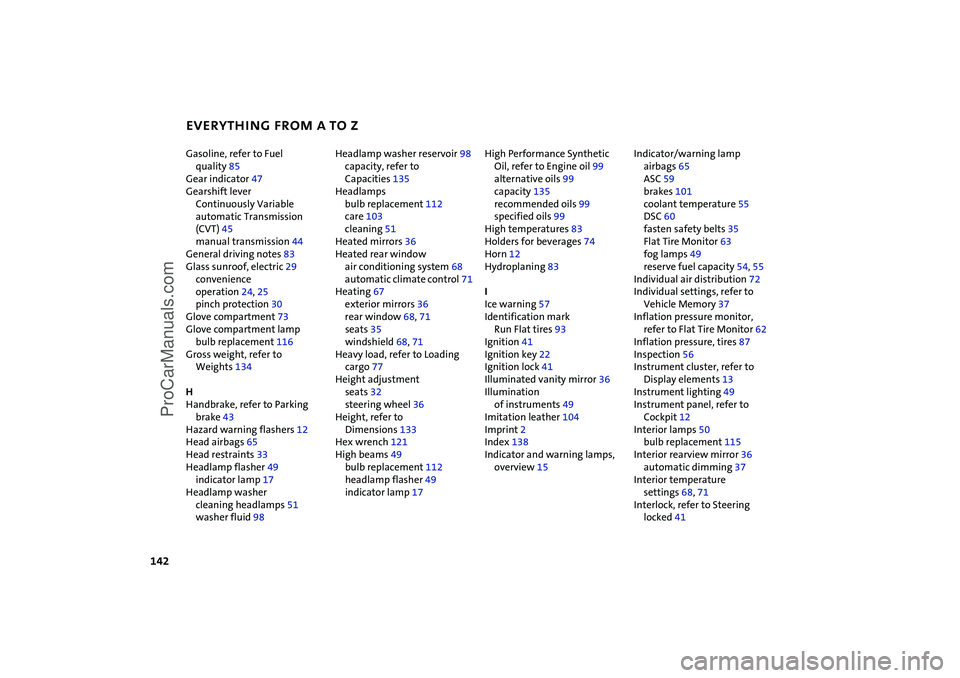
EVERYTHING FROM A TO Z
142
Gasoline, refer to Fuel
quality 85
Gear indicator 47
Gearshift lever
Continuously Variable
automatic Transmission
(CVT) 45
manual transmission 44
General driving notes 83
Glass sunroof, electric 29
convenience
operation 24, 25
pinch protection 30
Glove compartment 73
Glove compartment lamp
bulb replacement 116
Gross weight, refer to
Weights 134
H
Handbrake, refer to Parking
brake 43
Hazard warning flashers 12
Head airbags 65
Head restraints 33
Headlamp flasher 49
indicator lamp 17
Headlamp washer
cleaning headlamps 51
washer fluid 98 Headlamp washer reservoir 98
capacity, refer to
Capacities 135
Headlamps
bulb replacement 112
care 103
cleaning 51
Heated mirrors 36
Heated rear window
air conditioning system 68
automatic climate control 71
Heating 67
exterior mirrors 36
rear window 68, 71
seats 35
windshield 68, 71
Heavy load, refer to Loading
cargo 77
Height adjustment
seats 32
steering wheel 36
Height, refer to
Dimensions 133
Hex wrench 121
High beams 49
bulb replacement 112
headlamp flasher 49
indicator lamp 17 High Performance Synthetic
Oil, refer to Engine oil 99
alternative oils 99
capacity 135
recommended oils 99
specified oils 99
High temperatures 83
Holders for beverages 74
Horn 12
Hydroplaning 83
I
Ice warning 57
Identification mark
Run Flat tires 93
Ignition 41
Ignition key 22
Ignition lock 41
Illuminated vanity mirror 36
Illumination
of instruments 49
Imitation leather 104
Imprint 2
Index 138
Indicator and warning lamps,
overview 15 Indicator/warning lamp
airbags 65
ASC 59
brakes 101
coolant temperature 55
DSC 60
fasten safety belts 35
Flat Tire Monitor 63
fog lamps 49
reserve fuel capacity 54, 55
Individual air distribution 72
Individual settings, refer to
Vehicle Memory 37
Inflation pressure monitor,
refer to Flat Tire Monitor 62
Inflation pressure, tires 87
Inspection 56
Instrument cluster, refer to
Display elements 13
Instrument lighting 49
Instrument panel, refer to
Cockpit 12
Interior lamps 50
bulb replacement 115
Interior rearview mirror 36
automatic dimming 37
Interior temperature
settings 68, 71
Interlock, refer to Steering
locked 41
ProCarManuals.com
Page 147 of 152
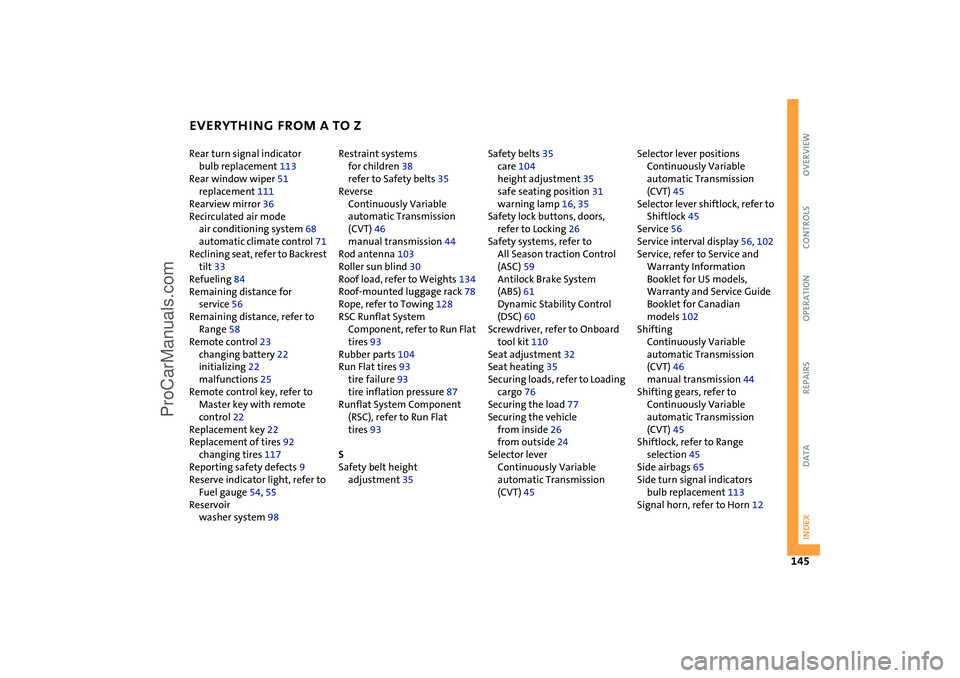
EVERYTHING FROM A TO Z
145
OVERVIEW REPAIRS OPERATION CONTROLS DATA INDEX
Rear turn signal indicator
bulb replacement 113
Rear window wiper 51
replacement 111
Rearview mirror 36
Recirculated air mode
air conditioning system 68
automatic climate control 71
Reclining seat, refer to Backrest
tilt 33
Refueling 84
Remaining distance for
service 56
Remaining distance, refer to
Range 58
Remote control 23
changing battery 22
initializing 22
malfunctions 25
Remote control key, refer to
Master key with remote
control 22
Replacement key 22
Replacement of tires 92
changing tires 117
Reporting safety defects 9
Reserve indicator light, refer to
Fuel gauge 54, 55
Reservoir
washer system 98 Restraint systems
for children 38
refer to Safety belts 35
Reverse
Continuously Variable
automatic Transmission
(CVT) 46
manual transmission 44
Rod antenna 103
Roller sun blind 30
Roof load, refer to Weights 134
Roof-mounted luggage rack 78
Rope, refer to Towing 128
RSC Runflat System
Component, refer to Run Flat
tires 93
Rubber parts 104
Run Flat tires 93
tire failure 93
tire inflation pressure 87
Runflat System Component
(RSC), refer to Run Flat
tires 93
S
Safety belt height
adjustment 35 Safety belts 35
care 104
height adjustment 35
safe seating position 31
warning lamp 16, 35
Safety lock buttons, doors,
refer to Locking 26
Safety systems, refer to
All Season traction Control
(ASC) 59
Antilock Brake System
(ABS) 61
Dynamic Stability Control
(DSC) 60
Screwdriver, refer to Onboard
tool kit 110
Seat adjustment 32
Seat heating 35
Securing loads, refer to Loading
cargo 76
Securing the load 77
Securing the vehicle
from inside 26
from outside 24
Selector lever
Continuously Variable
automatic Transmission
(CVT) 45 Selector lever positions
Continuously Variable
automatic Transmission
(CVT) 45
Selector lever shiftlock, refer to
Shiftlock 45
Service 56
Service interval display 56, 102
Service, refer to Service and
Warranty Information
Booklet for US models,
Warranty and Service Guide
Booklet for Canadian
models 102
Shifting
Continuously Variable
automatic Transmission
(CVT) 46
manual transmission 44
Shifting gears, refer to
Continuously Variable
automatic Transmission
(CVT) 45
Shiftlock, refer to Range
selection 45
Side airbags 65
Side turn signal indicators
bulb replacement 113
Signal horn, refer to Horn 12
ProCarManuals.com